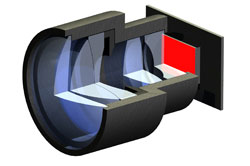Mini-beamer in a cell phone or PDA

Today, a choice has to be made whether to stay by the lake or watch the match on a big public screen or the TV set at home. In future, barbecue enthusiasts and football fans will be able to enjoy both at the same time. Cellphone TV is coming closer and with an innovative mini beamer it will be possible to create a public viewing event on a small scale – for example on a white bathing towel by the side of a lake.
The mini projector was developed by research scientists at the Fraunhofer Institute for Applied Optics and Precision Engineering IOF in Jena in cooperation with their partners in the EU project HYPOLED. Unlike conventional beamers it does not need an additional illumination system. Because the beamer can operate without an extra light source it offers a number of advantages: Firstly, it takes up little space. The prototype is 2.5 centimeters long, has a diameter of 1.8 centimeters and can be easily integrated in a cellphone or a PDA. Secondly, the device needs very little energy and therefore does not overtax the battery.
“The key component of the projector is an organic display, or OLED, developed by our colleagues at the Fraunhofer Institute for Photonic Microsystems IPMS in Dresden,” says Dr. Stefan Riehemann, group manager at the IOF. Currently the OLED display produces a monochrome image with a brightness of 10,000 candelas per square meter; for color images the brightness is about half that level. By way of comparison, a computer monitor generates about 150-300 candelas per square meter.
A lens system projects the image produced by the OLED onto a wall or other flat surface. The lenses are made of glass but the research scientists are already developing an optical system which uses plastic lenses. As plastic lenses can be embossed, they can be produced in larger quantities more simply and cheaply than glass lenses. At the Laser World of Photonics trade show from June 15 to 18 in Munich, the researchers are exhibiting a monochrome prototype (Hall B2, Stand B2.421).
Media Contact
More Information:
http://www.iof.fraunhofer.deAll latest news from the category: Physics and Astronomy
This area deals with the fundamental laws and building blocks of nature and how they interact, the properties and the behavior of matter, and research into space and time and their structures.
innovations-report provides in-depth reports and articles on subjects such as astrophysics, laser technologies, nuclear, quantum, particle and solid-state physics, nanotechnologies, planetary research and findings (Mars, Venus) and developments related to the Hubble Telescope.
Newest articles

“Nanostitches” enable lighter and tougher composite materials
In research that may lead to next-generation airplanes and spacecraft, MIT engineers used carbon nanotubes to prevent cracking in multilayered composites. To save on fuel and reduce aircraft emissions, engineers…

Trash to treasure
Researchers turn metal waste into catalyst for hydrogen. Scientists have found a way to transform metal waste into a highly efficient catalyst to make hydrogen from water, a discovery that…

Real-time detection of infectious disease viruses
… by searching for molecular fingerprinting. A research team consisting of Professor Kyoung-Duck Park and Taeyoung Moon and Huitae Joo, PhD candidates, from the Department of Physics at Pohang University…





















